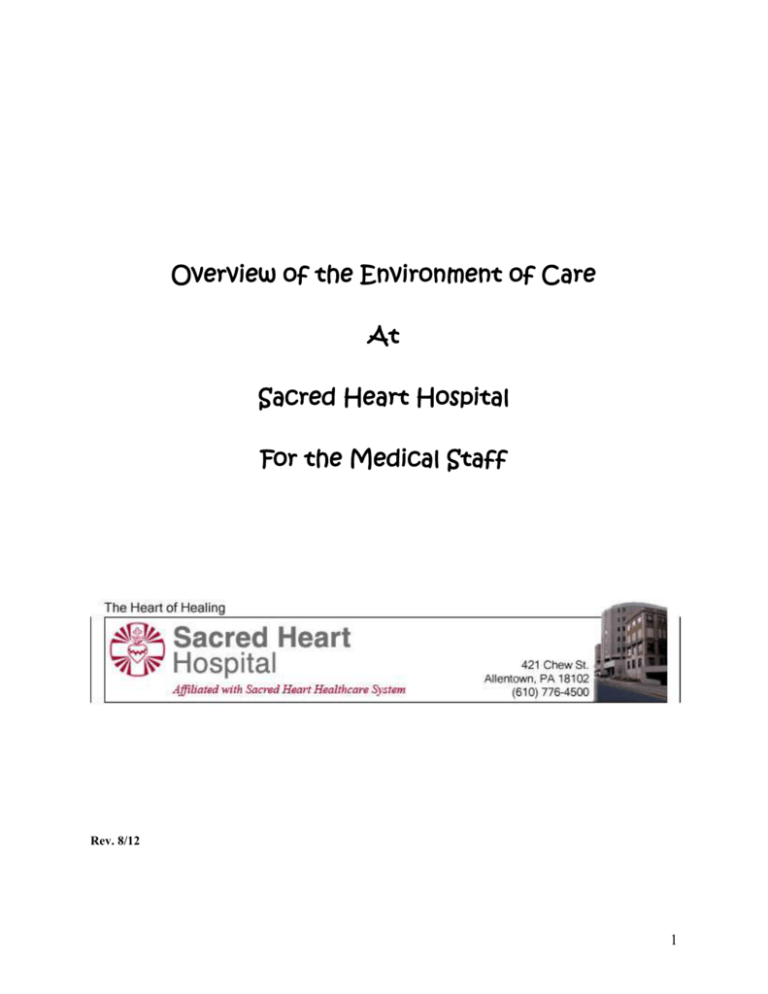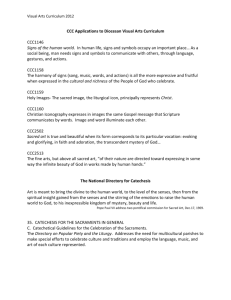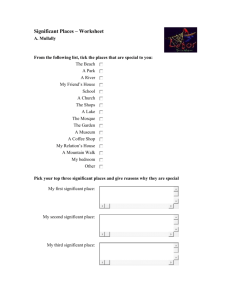Smoking - Sacred Heart Hospital
advertisement

Overview of the Environment of Care At Sacred Heart Hospital For the Medical Staff Rev. 8/12 1 Identification SHH ID badge should be worn at all times, per Sacred Heart Hospital policy, on the upper right chest. The badge is an integral part of our Service Excellence and Safety & Security programs. Parking at Sacred Heart Parking is available in our Chew Street decks. Contact Parking Office, 610-439-1568 for parking enrollment. Smoking Sacred Heart Hospital and its facilities are totally smoke free environments since November 15, 2007. No smoking is permitted in buildings, on parking decks, outside entryways, or on the loading dock. Dress In respect to the diversity of cultures, Sacred Heart Healthcare system adheres to a conservative dress policy. Jewelry should be limited, tattoos covered, visible piercings should be on ears only – no more than three per ear. 2 Americans with Disabilities Act: To comply with this act Sacred Heart offers services to those with communications difficulties. We have a listing of in-house interpreters which is accessible on the Intranet under General Information. Additionally, we subscribe to a language line phone service which offers interpreters in 140 languages. Access to this feature is made through the telecommunications operator. This can be accessed by staff 24/7. Patient /Work Safety Considerations Maintaining an environment that is conducive to the safe care of patients and the well being of our staff is a core aim of Sacred Heart Healthcare System. The following guidelines identify some basic common sense activities that should be a part of daily practice: WIWO: Wash in Wash out Wash your hands before and after each patient contact. This can be done using either soap and water or alcohol based hand gel. Clean up spills as soon as they occur. Use personal protective equipment as needed – they are provided at no cost to you. Adhere to all signage instructions. Be alert to people and happenings in your surroundings. Report any unsafe conditions to nursing staff. Infection Control & Prevention IT RESIDES WITH ALL OF US TO PRACTICE GOOD INFECTION PREVENTION EVERY DAY!!! HANDWASHING - the single most important procedure that you can do to prevent the spread of germs and viruses! Perform hand hygiene:: before eating, drinking, smoking, applying makeup, handling contact lenses, or using the bathroom you eat, smoke, cough, sneeze, or use the toilet. Bloodafter Borne organisms: after touching any blood, all body fluids, non-intact skin and mucous membranes, contaminated surface. after gloves are removed. How you can reduce your risk! Use Standard Precautions - treat all blood and body fluids as if known to be 3 TUBERCULOSIS How does TB Spread? TB is spread when an infected person with active disease sneezes, coughs or speaks. The tiny bacteria travel in the air currents and can be inhaled by anyone not wearing respiratory protection. The TB bacteria can settle in the lungs and grow or can spread to other parts of the body . Passive TB Infection In most people who breathe in the TB bacteria and become infected, the body is able to fight the bacteria to stop them from growing. The bacteria become inactive, but they remain alive in the body and can become active later. This is called TB infection. People with TB infection: TUBERCULOSIS Passive TB Infection : Active TB Disease the TB has entered the body but is inactive. TB is active and growing in the body no symptoms / skin test positive symptoms are present/ sputum positive (AFB) the TB cannot spread to others. TB can spread to others. Meds are given to prevent active disease Meds are given to cure active disease. Preventing Occupational Exposure OSHA requires health care workers with potential exposure to TB to be fit-tested with an approved respirator. Respirators at Sacred Heart Hospital are OSHA approved respirators that provide protection from aerosolized TB bacteria. This respirator must be worn by anyone entering the isolation room, including visitors. A regular surgical mask does not provide protection from TB. Fit testing is done by Employee Health, the Respiratory department or specially trained staff on each patient care unit. Airborne Precautions are used for suspected/known pulmonary TB cases 4 because the disease is transmitted through the air. It is not spread by direct contact or touching objects in the room. Private isolation rooms with negative airflow are used for patients with TB. Isolation rooms with negative airflow for TB are located on 7 Tower, 6Tower, ICU, Emergency Department. Staff must verify that the negative flow is turned on when a patient is in airborne isolation. Doors must be kept closed at all times. The chart must be tagged with the airborne isolation sticker, and an isolation sign is hung outside the patient’s room. Patients with suspected or active TB must cover the mouth when coughing and wear a surgical mask when being transported to prevent aerosolization of the TB bacteria. The Tuberculin Skin Test (TST) The PPD skin test is the only method available for demonstrating infection with TB. All health care workers are required to have the Mantoux skin test (TST) at least annually. This service is available to our medical staff personnel through the Employee Health Office located on the second floor of the Hospital. Additional information can be found in the Infection Control Manual. Waste Handling Waste is collected in various receptacles. Sacred Heart recycles office paper and aluminum cans. Clear bags are used for non-infectious waste. Red bags and containers are used for infectious waste, and yellow bags and containers are used only for chemotherapy waste. You are to identify and segregate the various waste streams at their point of origin. Paper bags are used on the psychiatric units for safety reasons. 5 WHAT IS INFECTIOUS WASTE? Infectious Waste is waste capable of producing a disease. Types of infectious waste recognized by the institution are: * Contaminated Sharps * Pathology Waste * Human Blood and Blood Products * Isolation Waste * Body Fluid Waste * Laboratory Waste Place in Sharps Box Sacred Heart has various needle/sharps safety devices available. Our intravenous needles are retractable. Other needles and sharps are have shields that are to be activated after use. If you need assistance with any device Please do not hesitate to seek assistance. * Contaminated Sharps, lancets, scalpels, scissors, broken glass, IV catheters, scalpels, blood tubes/used and unused. 6 PATIENT SAFETY Incident Reports (Event Report) A vital part of our compliance program An incident is anything that occurs outside of general hospital procedures. Incidents can result from a wide range of events. Some examples are: Inappropriate behaviors, falls, return to surgery, needle sticks, medication errors, elopement, etc. Whenever an incident occurs, the person who witnessed the event should complete an Event Report Online via the Intranet and forward to one of the list of reviewers. Back Safety/Ergonomics You are at risk for back injury, regardless of the department you work in, your position in the organization or the amount of physical work you perform Back injury not only affects your ability to contribute to the workplace and properly perform your job but also limits your ability to care for your family and enjoy leisure activities outside of work. Following basic back care concepts on a daily basis will reduce your chance of impairment. Successful injury prevention is the result of developing good lifting habits, utilizing good posture and incorporating these skills into your day to day activities both at work and home. Key Concepts to Remember: Maintain the normal curves of your back. Maintain a wide, stable base of support while standing/lifting. Lift with your legs, not your back. Keep items close to you when lifting or carrying. Pivot your feet. Don’t twist your back. Do not remain in one position for long periods of time. Exercise to keep muscles strong and conditioned. Smoking Learn ways to manage your stress. 7 The following lifting/moving devices are available in the hospital to assist with patient transfers: slide boards, gait belts, air pals, Total Lift II gurney/chairs, Hoyer lifts. SAFETY AND SECURITY How We Help to Maintain a Secure Environment The attendant patrolled Chew Street deck is open 24 hours a day. An enclosed walkway connects the 2nd level of the Chew Street deck to the hospital lobby. Direct access to the hospital from 5th Street Deck. Secured badge controlled hospital access after hours. The following areas are security sensitive and are locked units: Pharmacy, Birth Place, Emergency Department, OABMC, Adult Psychiatry, and EAC unit. Special policies are in place to govern clearance for access to these areas. A variety of engineered systems in place, such as camera surveillance, intrusion alarms, escort services, protective glass. Security can be accessed immediately if an additional presence is needed when the potential for a disruptive situation exists. Call at extension 3333. Your Responsibilities Keep your valuables at home. Keep alert to your surroundings; report any suspicious activity or persons. Wear appropriate agency identification at all times. You may alert our Security to any Protection from abuse orders. 8 Family Violence Family violence is epidemic in the United States. It affects every age, race, socioeconomic group, and gender. Abuse is an issue of the abuser wanting power and control over the victim. The abuse tries to gain power and control through emotional, verbal, sexual, financial or physical abuse. Sacred Heart Hospital has gathered a task force to look at policies and educate the staff and community. All patients at Sacred Heart cared for by a licensed professional caregiver will be screened and assessed for family violence. We want to make sure that the patient is safe. To ensure this we do the following: Identify the victims of family violence by screening the patient. Only screen when the patient is alone. “Are you safe at home?” “Are you in a relationship where you feel threatened or afraid?” Provide health support Document the information in the medical record. Provide the patient with the appropriate referral to Social Service and/or Turning Point. Report the suspected or actual abuse to the appropriate community agencies according to law: Children and Youth for children under 18 years of age. Area Agency for Aging for persons over 60 years of age who are at risk. Law enforcement agencies when permitted by PA law. Family violence is a social problem and a medical problem where we can make an impact on peoples’ lives. Ask the question, save a life. 9 Code Grey Why used? To deal with disruptions occurring because of behavioral disturbances on the part of patients or visitors. A Code Grey situation is any in which an individual (patient, visitor, etc.) demonstrates a clear and present danger to self or others. What happens? Calling a response team so that the How is it activated? Dial "Code Grey" activates a hospital based situation can be brought under control. "3333", and give your name and location and any other pertinent information relating to the incident. The hospital operator will announce "Code Grey and Location" 3 times. If a patient is involved, the nursing member calling Code Grey will remain as primary communicator, unless this task is formally handed off to a Code Grey responder. Who may call a Code Grey? Any member of the hospital staff may institute the Code Gray. If the occurrence is on a nursing unit, the charge nurse will coordinate team efforts to maintain patient/staff/visitor safety until the arrival of our specially trained response team. C.A.I.R (Crisis Assessment, Intervention, Recovery) Classes: Sacred Heart offers training in violence prevention and de-escalation as well as self-protection techniques for staff and team techniques to help patients regain control. 10 Infant/Child Abduction – Code Pink All staff have a responsibility to help with measures to limit the possibility of an infant/child abduction. You should always be alert to suspicious activities which could indicate someone who may be considering an abduction. Report to security immediately, x3333, any person who is displaying such behaviors. Suspicious Activity Repeat visitors with extreme interest in “babies” Theft of staff identification Extensive questions regarding infant-unit protocols Persons carrying infants instead of using bassinet Persons carrying bags, large packages, or loosely wrapped bundles from the unit. CODE PINK signals an infant/ child abduction. Stop what you are doing, look at your work area and halls and report anyone carrying a child or bag/package which could hold a child. The number to call to report an abduction or information related to an abduction is x3333. Care of Inmates (Hospitalized Prisoners) All inmates are accompanied by law enforcement agents who supervise them. These agents are referred to as forensic staff. Forensic staff receives information regarding our policies and protocols. This informational booklet is on all units and can be distributed to forensic officers. Any incidents related to forensic staff should be reported to Security. 11 HAZARDOUS MATERIALS PROGRAM Use PPE (Personal Protective Equipment) when indicated. PPE is provided at no cost to you. At Sacred Heart our Hazardous Materials Management Program consists of: Hazardous Materials Warning Labels Material Safety Data Sheets Education Program during orientation and annually. Types of Hazardous Materials flammable liquids corrosives lab chemicals cleaning agents, disinfectants office chemicals gases, such as in Operating rooms and dental suites hazardous drugs Material Safety Data Sheets Material safety data sheets (MSDS) are received by the health system for all hazardous materials it purchases. The Emergency Department maintains complete set of all (Safety manual) for products utilized there. Information is also available through the intranet. Chemical spills In the event of a minor spill (one which does not pose an immediate health threat), you should consult the container for directions in cleaning it up or consult the MSDS. If the spill is a major one or one which poses an immediate health threat: 1. Remove anyone in immediate danger. 2. Call 3333 - Code Orange. 3. Secure the area by closing doors. 4. Evacuate the area if necessary. 12 Calling a Code Orange will activate the spill response team who will then assess the situation and determine appropriate follow-up and clean up action. An incident report is completed for all spill events. A “Code Orange” is not initiated in situations of mercury spill or spill/leakage of radioactive substances. Special policies cover these situations. Radiation Safety Sacred Heart Hospital follows procedures according to the Nuclear Regulatory Commission in managing its Radiation Safety program. The presence of equipment in the healthcare environment poses special hazards to those who use it and to other health care workers. When portable x-ray equipment is being used in patient rooms, you will be asked to leave the room, to minimize your exposure to external beams. Signs are posted at all potential sites of exposure. Check with authorized personnel before entering these rooms. Remember that time, distance, and shielding have the most impact on one’s exposure. Minimize the length of time exposed; follow technician’s instructions regarding where to stand when portable x-rays are being done, and if you are a badged staff member, use the appropriate protective aprons provided. MRI Safety MRIs present special hazards in the hospital. The MRI is located in first floor radiology. They operate with a very large magnet positioned beneath the unit. People entering the room must be cleared by unit personnel. This even includes emergency responders. Please adhere to all signage posted on doors. It is essential that no one enter the suite until they have been cleared by MRI Suite technicians. 13 EMERGENCY PREPAREDNESS MANAGEMENT Emergency: an unplanned event caused by a fire, weather, utility failure, uncontrolled chemical release or community event, such as a bus accident, which results in an excessive number of injured patients. Two types of disasters: External - Identified as Code Triage, Internal - Identified as Code Purple. Our safety policies have been revised to be in compliance with National Incident Management System (NIMS) guidelines and incorporate the use of the Incident Command System to manage our response. The hospital disaster plan is located in the Safety Manual on each unit as well as on our Intranet. Unit specific plans are at the same location. To keep employees apprised of the status of an emergency event, the hospital has an Incident Command Notification Alert which is activated on the Intranet Home page. As part of our emergency preparedness plans, we participate with the Northeast PA Emergency Response Group (NEPAERG) and have signed a mutual aid agreement along with the other 17 hospitals in this group to assist each other with manpower, supplies, and equipment as needed. Bomb Threat (Code Black) If you take a call warning of a bomb threat, use the laminated blue card, accessible to unit phones, which gives guidelines and questions to ask of the caller. A paper copy of this questionnaire is located in the BOMB THREAT manual in the Safety Manual. Keep calm and direct energies to listening carefully to the characteristics of speech and sound of the caller. Try to obtain information as per suggestions on the blue card. Immediately after the call, notify the department head and Security. The announcement for a possible bomb threat is “Code Black”. Proper public safety officials will be notified. A search may be conducted. The decision to evacuate patients is made by public health authorities in conjunction with Hospital Incident Command 14 During a bomb threat situation, it is important to: Avoid use of pagers, cell phones, and 2-way radios. Overhead paging and use of telephones is acceptable. If searching an area, DO NOT turn on any lights when entering a room. DO NOT turn off any lights already on. LIFE SAFETY MANAGEMENT – FIRE SAFETY R.A.C.E. is our protocol to respond to a fire situation. R Remove (Rescue) any person in R A C E Rescue Alarm Contain/Clear Extinguish/Evacuate immediate danger and CLOSE the door. A Pull the alarm and dial 3333 to get the hospital operator. Inform the operator of the EXACT location and type of fire. (out of hospital, call 9-911) Pulling the alarm activates the ringing of bells which signal the building and floor of the alarm pulled. C Contain the fire by closing all doors. Turn off fans. Clear halls. E Extinguish the fire using hand held fire extinguishers, or wet blankets, etc., if possible. Evacuate if necessary. To use the extinguisher correctly, remember the "PASS" acronym: P A S S Pull the pin Aim the nozzle Squeeze the handle Sweep from side to side 15 Electrical Safety The integrity of the electrical equipment used in our facilities is vital to the prevention of injury to patients and staff. To ensure compliance with state and TJC regulations, Sacred Heart contracts with an outside vendor for testing, inspection, and repair of clinical electrical equipment. The Clinical Engineering department is responsible for this function. Any electrical equipment you bring to the facility must be inspected prior to use with patients. MEDICAL EQUIPMENT MANAGEMENT The Food and Drug Administration (FDA) requires that facilities that use medical devices establish a program that requires us to report patient events to manufacturers and the FDA involving devices and drugs. This allows the FDA to learn about any medical product that has caused a serious illness, injury, or death and to take action to track and/or recall the product for further action. The Sacred Heart Healthcare System policy that addresses this is General Policy #444. Definition of Medical Device - A medical device is any instrument, apparatus, implant, machine, implement, contrivance, in-vitro reagent, or other similar or related article or component which is used in the prevention, diagnosis, treatment, or care of disease. It does not include medications and/or drugs. How to report Safe Medical Device Act Events: Remove and impound the entire medical device(including all accessories) from service along with any packaging material. Do not dispose of the device without authorization from your supervisor. Deliver device to the Biomedical department for evaluation. Complete a health system incident report and forward to Risk Management within 48 hours. Incident report must include all manufacturer data: Serial number, Model number, Lot number, Manufacturer name, Control number. 16 Patient Bracelet Colors Red bracelet Allergies Orange bracelet Isolation Yellow bracelet Fall Risk Green bracelet Latex Allergy Purple bracelet No Code Blue Pink bracelet Do not use extremity In Conclusion You play a vital part in the safe operation of our facility. Please help us to maintain patient and staff safety by following our work rules as defined in our policies. You can report unsafe conditions or make suggestions for improvements to our environment either by speaking with your supervisor or completing a form at the suggestion box outside the cafeteria, or online on our Intranet. We welcome your input. 17 Key Names to Know: Corporate Responsibility Officer Tracy Burkhardt Privacy Officer 610-776-4981 Ralph Natale Radiation Safety Officer 610-776-5117 Michele Haupt James Zernhelt Patient Safety Officer Hospital Safety Officer 18 SUMMARY OF CODES DIAL 3333 for all Code Situations in the Hospital CODE RED - Fire Condition CODE ORANGE - Chemical Spill CODE PURPLE - Internal Disaster CODE BLACK - Bomb Threat CODE TRIAGE - External Disaster CODE PINK - Infant/Child Abduction CODE GRAY - Crisis Intervention CODE BLUE - Cardiac/ Arrest SECURITY - Priority In-house People to Know: Sacred Heart Healthcare System Safety Officer James Zernheltpage through Alpha paging or operator Director of Security Larry Heintzelman - Ext 4529, or page through Alpha paging or operator Risk Manager & Patient Safety Officer Michele Haupt - Ext. 4759, or page Infection Control Nurse Steve Schweon Ext. 4712, or page through Alpha paging or operator Employee Health Nurse Jodi Simon - Ext. 4805, or page through Alpha paging or operator 8/7/2012 19







